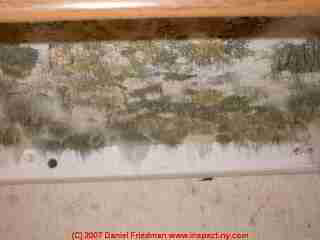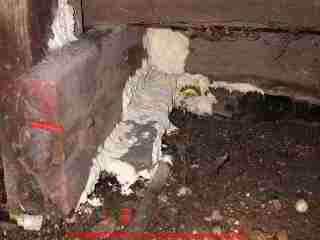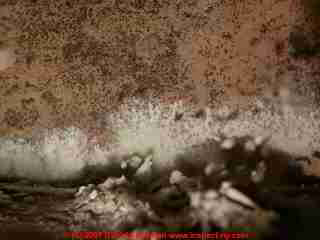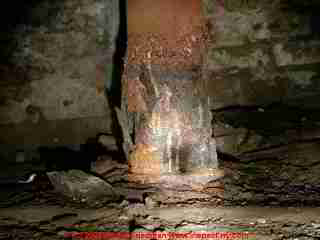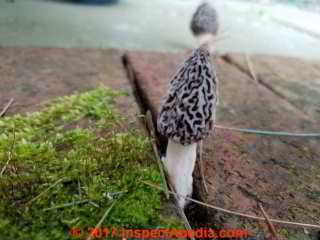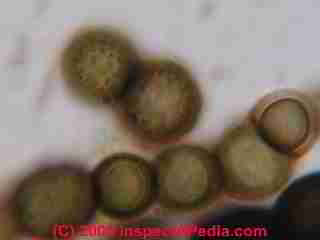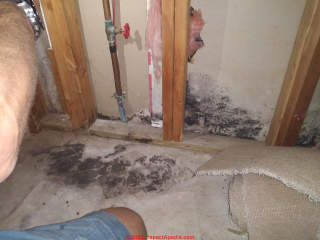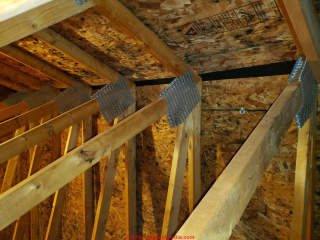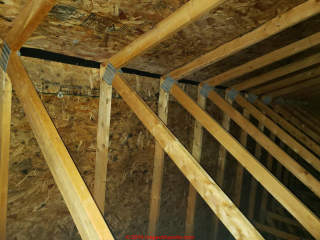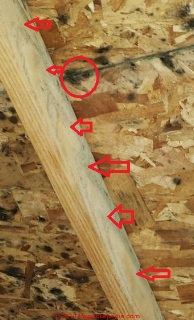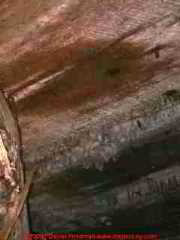 Age of Mold Contamination in Buildings
Age of Mold Contamination in Buildings
Surrounding clues can help estimate the age of mold growth
- POST a QUESTION or COMMENT about how to determine how old mold growth is in buildings
How old is the mold growth in a building?
This building mold contamination assessment article discusses how we can estimate the age and history of mold contamination in a building and how we can find evidence suggesting that a given mold contamination case is new, old, or includes both old and new fungal growth.
The appearance of mold genera/species varies widely as a function of the growth substrate (paper, wood, cloth) and moisture conditions.
InspectAPedia tolerates no conflicts of interest. We have no relationship with advertisers, products, or services discussed at this website.
How Old is This Mold? Is it Possible to Determine the Age of Mold in buildings?
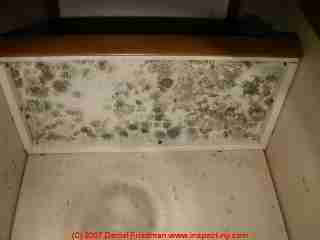 For insurance adjusters, building investigators, and building owners, a common question that arises when reviewing building mold contamination is "when did this happen" or "did the recent building leak or problem cause all this mold?".
For insurance adjusters, building investigators, and building owners, a common question that arises when reviewing building mold contamination is "when did this happen" or "did the recent building leak or problem cause all this mold?".
Here we explain how an experienced forensic investigator can find visual evidence that a mold problem in a building is of recent origin or if on the other hand the mold contamination in an area has been most likely present for a much longer time.
We will discuss: building conditions affecting the genera, species, and rate of fungal growth in buildings.
Conditions permitting an assessment of probable age of mold growth in buildings. How to evaluate mold samples for indications of active mold growth.
Evidence of Mold History in buildings, Evidence of Mold Age in Laboratory Samples. Insurance claims & water entry history & mold damage causation analysis.
A Single-leak event mold example
The mold photos above show the extent of fungal growth in a home which had no previous mold nor leak history but which experienced a burst-pipe flood followed by six months of inattention before an insurance claim was filed.
Thick fungal growth was present on some surfaces, and some fungal growth was present on most materials and surfaces with genera/species varying considerably depending on just what surface we examined.
For example, the edge of a door hosted a different genera/species than the face of the same door (different woods). (We conducted a survey to study just what fungal genera/species preferred just which building materials in this home.)
Was this mold due only to the burst pipe? The absence of other indications of recurrent water entry or rot supported the view that although the fungal growth was extensive, it was in response to a single event.
A multi-event long-standing leak condition mold example
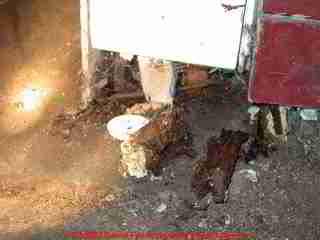
The mold photos above show thick dense fungal growth on rotted wood in a second building.
At the top of this page, a photo of similar-looking fungal growth as that shown in the "single-leak" case cited just above (by size, thickness, and extent below a wood subfloor) was was taken in a second building which had suffered decades of water entry.
It was much less likely that the mold growth we saw in the second building was due only to a single event flood.
Data like this can assist building owners and insurance claims adjusters in forming a reasonable opinion about the cause and age of mold contamination in a building.
In turn, that opinion can assist in setting priorities for building repair since if we do not correct the underlying causes for mold contamination in a building, mold growth is likely to recur and the investment in a given mold remediation project may be wasted.
A mycologist's view on setting an age on mold in buildings
Mycologists indicate and field experience by property inspectors confirms that fungal growth can occur in a building over a broad surface and quite rapidly, in as short a time as 2-3 days in some conditions and they add that it is not very reliable to guess at the "age" of a given mold colony.
Of course there are exceptions: some fungal growth such as "tree ears" and hard fungi produce slow-growing and durable structures over many years - the larger their size the older they are.
But in general, mycologists are precisely correct: looking at a sample mold itself does not easily permit us to guess how long mold has been present on that surface.
A building scientist's view on setting an age on mold in buildings
But the good news for building forensic analysis is that other accompanying observations in a mold-contaminated building can provide compelling evidence regarding the age of mold infection there.
A building scientist, particularly if s/he has also some training in mycology, can in some cases sort out the probable history of mold contamination in a building by using evidence from a variety of supporting sources.
Most buildings more than just a few years old are likely to have experienced an occasional spill, leak, or other source of water entry which could, in turn, have been a gating factor in developing problematic mold growth in the structure.
Buildings more than 20 years old, particularly wood-frame structures and structures which use interior materials which are "mold friendly" such as drywall, fiberglass insulation, and carpeting, often have had more than one leak, wetting or flooding event and may have more than one location and source of mold growth.
In fact a careful inspection of most homes, even ones which have never reported a flood or mold problem, can quite often, perhaps usually, find some spot of fungal growth in the structure. (That does not necessarily mean that the building has a "mold problem".
In all but the most egregious and uncommon cases such as brand new construction which has been flooded, a hasty, superficial scan of a building or of visible mold in it should not alone be a basis for deciding whether or not a mold problem has been long-standing or has occurred only as the result of a single most-recent building leak or flood.
However, thoughtful observation and recording of certain building conditions along with careful, thorough site and laboratory work can provide insight into the probability that mold found indoors at a particular building and at a particular time is probably due to a specific building wetting event or, on the contrary, that mold in a building, or at least some of it, probably pre-dates the specific wetting or flooding event.
In our separate article on detecting evidence of building water entry
see EVIDENCE of AGE & HISTORY of BUILDING WATER ENTRY or LEAKS
Conditions affecting the genera, species, and rate of fungal growth in buildings
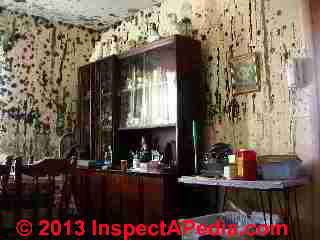 The appearance of mold genera/species varies widely as a function of the growth substrate (paper, wood, cloth) and moisture conditions.
The appearance of mold genera/species varies widely as a function of the growth substrate (paper, wood, cloth) and moisture conditions.
Different species prefer different moisture levels and thus may appear on the same material such as drywall but at different heights from the floor if that section of drywall was wet from the floor level. (Stachybotrys chartarum prefers very wet conditions and appears low on the wall.
In the extremely mold-contaminated building shown at left, the author tested every surface of every different type of building material found inside the structure.
The results were interesting: different mold genera/species had strong preferences for different materials (no surprise).
Cladosporium and Ulocladium are often found somewhat higher on the same wall.
Aspergillus sp. or Penicillium sp. often prefer still less wet conditions and may be found higher still or more uniformly spread over a drywall surface as they may grow more readily in conditions of high humidity even if the drywall was not actually wet to the touch.
What produces mold growth on a building surface is the combination of this presence of omnipresent fungal spores available in the general environment, the presence of a building material that a particular fungus will grow on (its food), and the presence of appropriate conditions of moisture and, to a lesser degree, temperature and perhaps light or darkness.
If these mold-conducive conditions have been present in a building for months or years, the probability that a fungal growth has appeared suddenly and as a sudden and brand-new mold colony is rather low.
Conditions permitting an assessment of probable age of mold growth in buildings
All of these mold-producing conditions are likely to pertain and should always considered in both field and laboratory examinations of moldy conditions in any building where mold contamination is present.
Of course for any specific case of mold contamination in a building, only some of these conditions will actually be present and determinant of mold growth in a particular building and case.
Water leak history sets a probable age of mold
Evidence of a history of recurrent water entry in a building will establish that mold-producing conditions have been present since the beginning of those water or wet conditions in and at the property. These include both:
- Evidence of water-entry producing conditions (missing gutters, in-slope grade, improper ventilation, history of plumbing leaks, multiple flood lines in a building) and
- Evidence of the effects of water entry (water stains, damage from rot or insects, visible mold). Mold spores are available in the environment nearly all of the time under all conditions.
Evidence of rot sets a probable age of mold
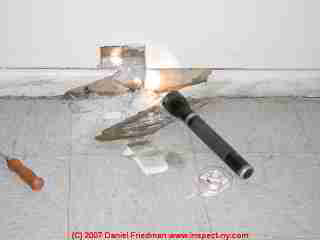
Evidence of rotted wood components such as flooring, framing, floor joists, sill plates, or posts.
While water entry can occur suddenly and can be extreme (flooding, burst piping, sudden severe roof leaks), the conditions produced by a first-time and one-time event, if inspected days, weeks, or even several months after the event, will not include rotted components.
The floor trim in the photo above is not only moldy, a closer examination shows that it has rotted.
The rotted condition of the trim indicates long-term exposure to water and makes it less likely that the mold on the trim is due only to a single recent leak event.
The photo above examines the wall cavity behind this rotted floor trim, showing additional wood debris and mold growth on the cavity side of drywall in this building.
Evidence of exfoliating rust sets a probable age of mold
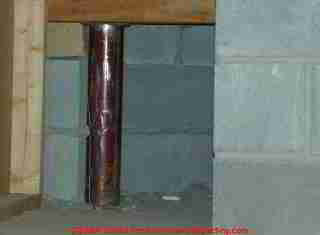
Evidence of exfoliating rust on steel components such as steel Lally columns, teleposts, or steel heating furnaces or boilers, is evidence of recurrent or protracted wet conditions which are also mold-conducive.
"Exfoliating" or thick flaking rust, or even rust penetration of components, is to be distinguished from light, superficial rust that appears readily on unprotected metal surfaces after a single wet event.
The photo at above left shows no building-related rust on a steel lally column in a dry crawl space. This area has not been subject to severe recurrent water entry. The second photo at above right shows exfoliating rust on a steel lally column, clear evidence that this space has been subject to recurrent and/or prolonged (many months) water entry.
Indirect evidence of moist conditions can suggest probable age of mold
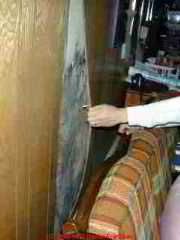 The photo showing me pulling away perfectly-nice looking wall paneling to disclose a decades-old mold contamination issue from a single-event basement flood makes the point that that a single event that soaks a building can produce a large mold reservoir that might be left un-attended for a long time.
The photo showing me pulling away perfectly-nice looking wall paneling to disclose a decades-old mold contamination issue from a single-event basement flood makes the point that that a single event that soaks a building can produce a large mold reservoir that might be left un-attended for a long time.
Details about this case are
Evidence of wood destroying insect activity
is suggestive of moist or wet conditions as those invite insects into a building; other conditions such as wood-soil contact are also factors in the development of insect damage.
Evidence of age of mold in the forensic microscopy laboratory
- Condition of the mold or fungal colony itself,
examined microscopically, may be suggestive of the length of time a mold infection has been present on a surface. - Dry desiccated fungal material
is consistent with prior, currently inactive fungal growth on the surface which was sampled. - Fresh, hydrated fungal hyphae
or fungal fruiting bodies (conidiophores or other sporulating bodies) are consistent with ongoing, current fungal growth. Some fungal bodies such as thick woody structures grow much more slowly and if present, almost certainly have been developing over a long time. - Of course, both types of fungal presence may be found
on a surface, thus indicating that there is both a pre-existing moldy condition and current or renewed fungal growth.
Mushrooms - "overnight" appearance of fruiting bodies of some mushrooms
In nature fungal growth can appear outdoors even more rapidly: some species of mushrooms may appear after a rainy night.
Notes about these clues to the age of mold or mushrooms found in, on or around buildings (Identification of True Morel mushrooms) - see details
at MOREL MUSHROOMS, IDENTIFICATION & DRYING
- In nature fungal growth can appear outdoors even more rapidly:
some species of mushrooms may appear after a rainy night.
The morel mushroom shown in our photo above appeared just about overnight, sprouting up in a brick entry walkway - these dark gray morels, probably not the yellow Morchella eseculenta variety, were, however not good to eat - growing in pine-needle-covered soil their taste was horrible.
In contrast, the more-typically-coloured light beige morels, Morchella esculenta, are quite edible. - Rotted components from a single event leak may be present
if the building has remained wet for more than a month or two, but that case can still be visually distinguished from prolonged water exposure, recurrent water exposure, multiple flooding events, and extensive deep rot in wood members by visual observation and experience. - Also see MOLD & MUSHROOMS INDOORS on DIRT FLOORS
Unambiguous, Ambiguous and Overlapping Mold Colonies in buildings
Especially in older buildings where there has been a recent sudden leak event associated with mold growth, it is often possible to identify pre-existing mold as well as mold-producing conditions.
In unambiguous cases, the "new" mold associated with the building leak event may, by luck, appear in a limited area of the building which maps the area wet by the recent leak, and separated by distance or building area from other moldy areas which in turn are associated with other building leaks or conditions.
The physical separation of wet areas and wet conditions may be sufficient to make a clear assignment of mold causation in such cases.
In ambiguous cases, there is fresh, active fungal growth, probably associated with a recent leak or flooding event in the building, which has grown entirely or partly overlapping pre-existing mold growth.
In this case the assignment of cause and age of mold in the building can be ambiguous. If an insurance claim is involved, insurance company policy details and internal claims adjustment guidelines will determine the extent to which insurance coverage will address building remediation and repair for these overlapped-occurrence mold conditions.
Determining Whether or Not a Mold Test Sample Shows Active Mold Growth
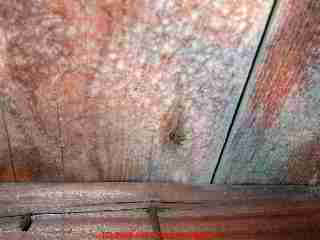 Question: how do we determine whether or not mold in a building is active vs. inactive?
Question: how do we determine whether or not mold in a building is active vs. inactive?
Would you please let me know how an individual (or lab) would test for whether a mold found on attic sheathing is active vs. inactive?
Research on-line has told me the test for active vs inactive is whether it smears when you rub it. Is there a more technical test that can be done? Should a lab be able to tell me this when I supply a sample? - M.O.
Answer:
The question of how we determine whether or not mold in a test sample is "active" is a bit misleading, although some surface test samples of mold do indeed give compelling evidence of recent active fungal growth.
Our site photograph of moldy roof sheathing (above) is an example. Is this mold growth "active" or "inactive", and does activity make much difference in risk to building occupants?
Here discuss visual clues that help determine the age of mold contamination in buildings or on building surfaces. There we explain what dried, desiccated, "old" mold growth may look like on a surface, in a test sample, and under the microscope. Among other factors, we distinguish between
- Dry desiccated fungal material is consistent with prior, currently inactive fungal growth on the surface which was sampled. Very desiccated sample materials are almost certainly not indicators of active current fungal growth.
- Fresh, hydrated fungal hyphae or fungal fruiting bodies (conidiophores or other sporulating bodies) are consistent with ongoing, current fungal growth. Some fungal bodies such as thick woody structures grow much more slowly and if present, almost certainly have been developing over a long time.
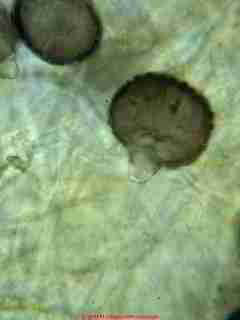
Often we can confirm recent fungal growth in a tape sample by the presence of certain growth structures, hyphal buds, or even the state of a conidiophore.
Our photo of Epicoccum sp. fungal spores and hyphae (above left) collected from a building surface shows intact, fragile hydrated complete spores still connected to hyphae - this mold growth is recent and might indeed be considered "active mold growth" as would the intact, hydrated, and budding Aureobasidium pullulans spores shown in our second lab photo (below).
This burst of Pleospora spores is clearly active. Similarly, for certain species that produce long fragile spore chains, the presence of long mold spore chains is certainly indicative of nearby active fungal growth, as these chains break up rapidly into individual spores when airborne.
Conversely, highly desiccated, fractured, or damaged fungal material that lacks budding hyphae or sporulating intact conidiophores are almost certainly "inactive" mold growth in the spot where sampled.
Sources of Mistaken Conclusions about Mold Risk in Buildings

Watch out: "mold activity" or "mold inactivity" can be misleading conclusions about the risks associated with mold growth in buildings.
The moldy books in a college library (photo at left) were in the opinion of some people "an old inactive mold problem" but when workers began dehumidifying the area in preparation for a mold cleanup, visible clouds of Aspergillus sp. spores were released into the air by small air currents caused by simply walking down the aisle between stacks of books.
- Mold test sample size
Because a sample represents a small area of a building and of time, and because other materials may be present that the sampler did not see, detect, or test, a single sample is an indicator, not a conclusion about a building's condition. - Multiple mold genera/species
Next, the conditions that produced fungal growth that was seen and tested mean that building conditions were ripe for mold growth, perhaps on other surfaces or in cavities or in less visible locations.
For example we may see one species of mold on an attic roof underside, say Cladosporium cladosporioides, perhaps even desiccated by the heat of sun beating on the roof, while the conditions that produced that growth also produced a non-visible but more troubling Aspergillus sp. contaminating growth in building insulation in the attic floor.
So at a given time, some mold on building surfaces may be "inactive" while nearby another genera/species may be growing like mad, or releasing spores like mad, i.e. "active". - Dead toxic mold
Next, we suspect an underlying faulty premise that the salient question is whether or not a fungal growth is active or not in a building. In fact even currently inactive (no apparent recent fungal propagation) fungal presence on a surface can be a hazard since spores and fungal hyphal fragments may be toxic, pathogenic, or allergenic even in that state.
That point remains true even if some misinformed "mold remediator" tries to "kill" the fungus with a fungicide or bleach. - Smearing mold?
Further, he claim that smearing mold with a finger determines whether or not it is active or not is nonsense.
A mold growth on a surface could be very desiccated and may not have actively propagated for a long time but still can be "smeared" with a finger wipe.
But we agree that if you cannot smear suspected-mold or better, if you cannot obtain particles on an adhesive tape sample, then the surface may have been previously cleaned, and what remains may be no more than a cosmetic stain. - Inoculation of mold
Finally, even if mold is "not actively growing" at the time that a sample is obtained from a surface (or in dust or air), the presence of a large amount of fungal material in a building can lead to rapid mold re growth and propagation when building conditions change to those more conducive to growth of the fungi already present.
All mold is everywhere all the time in the form of spores ready to inoculate a material or surface. So when building conditions are ripe for mold growth, it is likely to occur.
Predominantly, it is the building conditions that determine whether or not we will have a building mold problem, not the presence or absence of mold in general. But the presence of a large reservoir of pre-existing (inactive) mold can speed both the recurrence and the extent of a future mold contamination. "Inactive" does not mean "non-viable".
Watch out: however: using a swab or culture test for "viable mold" in buildings can give very misleading results since what grows in the culture is what likes the culture, not necessarily what is present or dominant in the building.
See MOLD TESTING METHOD VALIDITY and in
particular MOLD CULTURE PLATE TEST ERRORS
These reasons explain why in addition to testing to confirm the presence of mold growth, and to confirm that it is not simply cosmetic, in cases of possibly costly mold cleanup or diagnosing a possible building contribution to indoor air quality complaints, is important to have an expert perform a competent inspection of the building.
Also see MOLD GROWTH on SURFACES for an index of what mold genera/species are frequently found on various building surfaces and materials.
To better understand the water entry or leak history of a building - gating factors in mold contamination,
see EVIDENCE OF AGE & HISTORY of BUILDING WATER LEAKS
Reader Comments, Questions & Answers About The Article Above
Below you will find questions and answers previously posted on this page at its page bottom reader comment box.
Reader Q&A - also see RECOMMENDED ARTICLES & FAQs
Question: Is there any way to tell how long this mold has been in our home?
Is there any way to tell how long this mold has been in our home. We are renting and have only lived here for eight months, we never knew this water valve was under the stairs until we told our landlady yesterday that our children's bedrooms have mold growing in them.
She said she has never had mold in the home before but the first place she went to look was underneath our stairs i
If you're trying to blame us for the mold but this area is nowhere near the mold that's growing in our kids bedroom
Moderator reply: Yes within bounds of: brand new, few days, weeks, months, years surrounding clues can tell us the age of the cause of mold contamination
Tammy:
Even before pulling trim or inspecting more broadly for other clues that help answer your question, it's worth noting the significant green oxidation or corrosion on that water pipe down near floor level. That along suggests that there has been a leak here for quite some time.
When we don't know the exact date of a specific event to which mold growth is ascribed, nevertheless it is often easy to at least determine if the mold has grown in the past 1-2 days (mold can appear growing on drywall, for example, in 24-48 hours after a wetting event, varying by building conditions) or if there are indications of a water source that has been present or leaking for weeks, months, or longer.
To make a reasonable estimate of the age of mold growth in or on a building material please take a look at
AGE of MOLD GROWTH - inspectapedia.com/mold/Age-of-Building-Mold-Growth.php - now above on this page - Ed.
Further investigation would be appropriate
first to determine the extent of mold contamination and
second to be sure we've properly-identified the water source
because the correct procedure is to
remove the mold
and find and fix its cause
(Moldy carpet can't be cleaned, it's to be tossed out, same for drywall and insulation)
Finally: if the water that caused the mold growth in your photo did not extend to your kids' bedroom then we may need to find a separate leak source in the building.
On 2019-10-02 by Joseph - how old is this mold growth on OSB roof sheating in a 2005 home
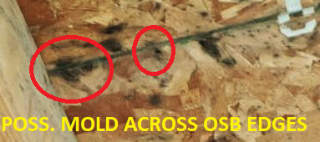 Mold was discovered in our attic during a home inspection. It is widespread and almost entirely on the ceiling (under roof) plywood/OSB.
Mold was discovered in our attic during a home inspection. It is widespread and almost entirely on the ceiling (under roof) plywood/OSB.
The house was built in 2005 and there has not been any water issue in the attic. A contractor friend looked at it and was baffled.
The conditions are very dry, there are no signs of any water infiltration, and all the ventilation is proper (ridge vent and soffit are proper and not blocked).
He said he can "feel" fresh air. His best guess is that the mold has been there since the house was built and likely was due to the sheathing being wet/damp at the time.
Does this sound plausible? Could the mold have been sitting there dormant all these years?
Is there any way to tell, and does it even matter? Should it all be removed? So many questions.
On 2019-10-02 by (mod) - evidence of mold growth after original construction - mold crossing OSB butt joints
Joseph:
It is possible that the mold came in at time of construction, particularly if the following are true
- at no point where there is a joint between the OSB and an abutting surface such as a truss or abutting OSB sheet can you find an individual mold colony or "spot" that has grown across that boundary. For example in your photo there is mold on the OSB but not on the second truss from left.Taken alone absence of growth from OSB onto truss is not sufficient evidence since building materials differ in their mold-friendliness, but absence of mold growing across an OSB to OSB border between two sheets would be significant.
A closer look at your photo shows this possible cross-OSB-border growth
In my OPINION from the VERY limited view of your attic I suspect the intake and maybe outlet venting are incomplete - certainly those baffles are incomplete, venting roughly half the space between trusses. And is there a good ridge vent?
I'd need to see more of the attic
IF the mold is ONLY in this one area that you show (you say it's widespread) then I'd suspect a local moisture source such as a nearby improperly-handled bath exhaust vent.
I'd want to inspect the whole house for moisture sources; e.g. if there is a wet crawl space or basement then that moisture is likely to move up through the structure into the attic.
Finally: IF mold arrives on OSB sheathing, and considering how that sheathing is applied to homes, it's likely that not every sheet is placed with the same side "up" - so mold would have to have been equally contaminating both sides of every OSB sheet (which is possible).So if in an attic we see some adjacent OSB sheets that are very moldy and abutting sheets in the same area of the attic that are mold free, that'd argue for "on-arrival" mold.
I do NOT claim that your mold is harmless - it's likely to be at least allergenic; and of course there will be multiple genera/species present.
But COSMETIC MOLD, RECOGNIZE will show you examples of abutting moldy and not-moldy surfaces that demonstrate mold that came in on framing lumber at the time of construction.
Give me more detail and photos if you can and do keep us posted as this is an important question that will also assist other readers.
Thanks for asking.
On 2019-10-02 by Anonymous - more photos of mold on OSB roof sheathing
Thank you for your reply.
Joe
On 2019-10-02 by (mod) - evidence that mold is growing in this attic
Let's take a careful closer look at those dresses. I think I see a bit of mold growth on those surfaces and some of your photos.
As I've marked in this clip [above] from one of your photos, Mold growth on both OSB and trusses suggests this mold grew in the attic and did not simply come in on moldy OSB at time of construction.
Bottom line: there is evidence that mold has grown in this area after the time of original construction. I see what looks like individual mold colony growing across OSB butt joints and more-limited mold growth on the sides of some of the trusses.
That does not mean that the OSB was mold-free at time of construction.
If (and I do NOT recommend this) one were doing destructive inspection you'd look along the OSB in-attic surface between the upper side of the truss and the under-side of the OSB - as a variation in mold pattern there would also be diagnostic.
On 2019-05-31 by SL - did anyone find a physician to help with mold related illness?
@cc
I am having a similar situation to CC and am also in NYC. I am wondering if CC ever found a physician to help her and her family?and what happened with the building. Thank you
On 2019-05-31 by (mod) -
SL
At MOLD DOCTORS
https://inspectapedia.com/sickhouse/Mold_Doctors.php
Find a directory and registry of mold and other environmental doctors. Give that organization of call and they can help you find a suitable doctor close to you.
On 2018-10-06 by CC - We have Aspergillis at a level of 410,000
Hi, thank you for writing and linking some great info. My family of four has become quite ill from mold growing behind our walls and into our NYC coop apartmen. My husband and I are in good health, as were our two toddlers ages 2 & 3.
Then we all started getting sick. We blamed it on toddler teething and preschool and seasonal changes or newfound allergies and ultimately just being run down and exhausted. I got to the point of throwing up blood and both of the kids were having severe discomfort, dizziness, sore throats, and skin rashes.
We went to the doctors and peds and I was tested (negative) for strep, and my 3 year old also had no ear infections or pneumonia.
I was given steroids and ultimately antibiotics because they couldn’t figure out what was going on. We then moved out for the summer (2 months) and my father moved in and developed severe pneumonia that left him hospitalized this 4th of July.
We basically all though nothing of connections and ultimately thought the baby’s skin rashes as well as mine and our mouth sores were hand foot mouth after strep was negative twice. We started to recoup and then moved back the end of August (all the while never knowing of this mold issue!).
Then we all started getting sick again (this has now been over a year of illness after illness yet at the beach we have recouped (assuming fresh ocean air does the trick!).
For the last month we have been severely ill coughing, dizzy to the point of sitting down holding onto the fridge door with it open because I could no longer stand. We all vary slightly with my 3 year old and I being more dizzy and sore throat and cough, where my husband and 2 year old are slightly dizzy but coughing and sneezing and have more nasal drainage. We have skin and eye irritation and headaches and the list goes on.
Moral of this is we found the leak (upstairs neighbors kitchen sink) and the super has repaired and they have opened a liability claim. (The mold farm is significant in size...approx a foot wide and runs all the way up the back of the cabinets to the ceiling!).
It is growing and doing so quickly. It is contained behind plastic now yet not remediated and their adjuster only just came today and will be out on vacation for 2 weeks. We are left paying everything out of pocket including accommodation but aside from that we have moved forward with testing.
We have Aspergillis at a level of 410,000 which I understand is extremely high which is in line with our symptoms. Our pediatricians are taking the stance that there’s nothing to do and our GP is unaware of mycotoxin testing. I am struggling to get the specialists and any testing at all! The kids have had basic blood work and the baby has elevated platelets quite outside of the normal rates.
They have a few other numbers that are amiss but we cannot even get into a ped pulmonologist until nov 2!! I can’t find any labs that are reputable to do testing and our doctors are not fantastic. At the point where both my husband and I have been loosing feeling in our toes and me in my tongue as well, I would think this would be taken more seriously or there would me more experts in NYC!!
I actually have some of my dried blood sputum in a cup from June (it was just so weird that I thought i about to die of cancer or something and intended to see if I could test it for what was going on). As it stood because the kids were so sick, this got set on a shelf and dried but I’m curious if it’s still testable to see if Aspergillis was present and if I have Asperilliosis.
The building and neighbors and no doubt their insurance company will most likely say this is recent and I am not wondering if many of the health issues my family has had in the last year could be related to this.
My son is developing a speech delay, got pneumonia and my baby got a staph infection and sever skin rashes.
My husband had knee fluid test oddly enough that they referred him to an oncologist that was thank god just a scare but the mucin and other figures seem like there could be a mold impact issue there. We are not trying to sue provided they remediate and house is elsewhere until the air levels are safe, and we own so we cannot just break a lease and are invested (literally and emotionally) in this home.
That said, we are all so sensitive at this point that the baby had a coughing fit the other day and we could not figure out what was going on and unbeknownst to me, my husband had gone home to quickly retrieve his work laptop and the baby had fallen asleep on his shoulder when he was wearing the same suit jacket from his earlier entry. We have professionally cleaned, thrown out, or left anything pourous and are quite a site moving hotel rooms via garbage bags as we cough and have mismatched clothes.
Least of my problems, but basically this is a long winded story where I’m trying to decide if I need to get further testing on the wall before it’s knocked down and how best to determine its age since we have had symptoms for some time now without seeing it. A forensic toxicologist? A more detailed lab result? Rug or surface testing? (We did a swan of the mold and an air test in each room so far).
All of this is out of pocket at the moment so I cringe at the expense but likewise I think I need as much info as possible so I can tackle our health approach. Likewise, what medical tests can I do and how can I confirm our length of exposure?
Can I test bloody sputum from June or would it be dead or irrelevant by now? Apologies but I’m watching my kids have coughing fits and wail in the middle of the night and the pediatricians say their lungs are clear and we can’t do anything more.
There must be more we can do here?! Medicine, blood tests, urine tests, specialists, but everything sounds like an online scam, or a month long wait or an ER visit so my head is spinning....literally! :(
On 2018-10-06 by (mod) - Find a doctor whom you trust and follow her advice.
CC
From the case that you've described so far it sounds as if the actual scope and extent of mold contamination has not been thoroughly identified and you don't know the scope of remediation needed.Watch out: While air tests for mold are very inaccurate, any "test" suggesting a high level of indoor Aspergillus sp. means that there is likely to be a serious health hazard present.
But more urgent is it seems that you need a referral to a specialist and environmental medicine who is familiar with mold related illness. I wouldn't be surprised if that specialist recommended that you should not have your family in the questioned Environment until the most question has been sorted out.Find a doctor whom you trust and follow her advice.
On 2018-09-08 by Mark - Can one tell the age of a mold from the air.
Can one tell the age of a mold from the air. My insurance doesn’t want to pay, after a burst pipe that damaged my basement and their restoration company not cleaning the basement properly causing mold to grow. Now, the insurance is stating that the mold pre-date the water damage. They checked they air. Is this true, or is this just a way to not pay.
On 2018-09-08 by (mod) - no
No Mark. An air test for mold can determine (with a significant risk of error, especially of a false negative or of missing an existing problem) that there is a nearby mold colony but not the age of the mold colonization.
To do that, even roughly, requires a competent visual inspection of building conditions and a review of its leak history. In the article above I give examples of what an experienced investigator would consider.
Question: rental unit is coverd in mold, how can I determine how long it's been there?
(June 9, 2016) Yvonne said:
I have a unit that was inspected 2 weeks ago and is now covered in mold. How can I find out how long it's been there?
Reply:
My best suggestions are in the article above. If you see something in that article that raises a specific question just ask. I'm not sure what "inspected" meant 2 weeks ago; but a leak that wets building materials such as drywall can result in a serious mold contamination problem in 24-48 hours.
Question: scientific research about effects of bringing moldy stuff into a new home?
(Aug 31, 2016) Bazia said:
What if any science exists about inoculating the house we just bought by bringing items from the moldy house we are moving from. Lots of suggestions online of leaving everything behind to keep the next home healthy and uncontaminated.
Reply: What if any science exists about inoculating the house we just bought by bringing items from the moldy house we are moving from?
Bazia,
There is certainly a possible problem with bringing in mold-contaminated materials into a new clean home as they may prove irritating or even a health hazard to occupants, depending on how sensitive the occupants are to the molds on the items imported and the amount of contamination.
A client whose home I had investigated was in hospital after becoming seriously ill with mold-related respiratory illness.
She was nearly recovered and was ready to return home. Her husband brought her a change of clothing that had been stored in a closet in the home. Exposure to the clothes was enough to send the client into severe respiratory distress.
But you do NOT need to abandon everything from a moldy home. That nonsense comes from people spending YOUR money to reduce THEIR RISK. I gripe about this problem in depth at inspectapedia.com/home_inspection/Other_Peoples_Money.php
- Items of soft goods (clothes, bedding, towels) that can be laundered or dry cleaned should be fine.
- items that are hard-surfaced can be washed - dishes, wooden furniture, metal objects.
- Electronics like a stereo can be just surface-wiped or if very dusty HEPA vacuumed.
- A mattress that was covered with bedding but that never was itself wet, covered with mold growth, nor smelly, can be HEPA vacuumed and salvaged.
- Heavy upholstered furniture (couches for example) that was wet or moldy is not economical to clean, cannot be effectively cleaned, and would normally be abandoned. The cost to strip, clean the frame, and re-upholster it will usually exceed replacement cost.
I am less worried about inoculating the house itself. As my teacher, friend, mentor and NY State Mycologist John Haines used to exclaim, "all mold is everywhere, all the time" - that is, airborne spores are naturally-occurring in outdoor air and in building air. It is building conditions - dampness, wetness, leaks - that invite problem mold growth. Keep your new house dry and clean.
Longer term monitoring of previously flooded, mold contaminated homes does find indoor mold problems in many homes but in my experience it is almost always going to be due to incomplete demolition and cleaning.
- Pearce, McGregor, Patrick H. Huelman, Kevin A. Janni, and Wanda Olsen. "Long-term monitoring of mold contamination in flooded homes." Journal of Environmental Health 58, no. 3 (1995): 6.
- Chew, Ginger L., Jonathan Wilson, Felicia A. Rabito, Faye Grimsley, Shahed Iqbal, Tiina Reponen, Michael L. Muilenberg, Peter S. Thorne, Dorr G. Dearborn, and Rebecca L. Morley. "Mold and endotoxin levels in the aftermath of Hurricane Katrina: a pilot project of homes in New Orleans undergoing renovation." Environmental Health Perspectives (2006): 1883-1889.
- Macher, Janet M., Fan-Yen Huang, and Martha Flores. "A two-year study of microbiological indoor air quality in a new apartment." Archives of Environmental Health: An International Journal 46, no. 1 (1991): 25-29.
...
Continue reading at HIDDEN MOLD in PANELING or select a topic from the closely-related articles below, or see the complete ARTICLE INDEX.
Or see these
Recommended Articles
- COSMETIC MOLD, RECOGNIZE
- DIRECTORY of MOLD / ENVIRONMENTAL EXPERTS
- MOLD / ENVIRONMENTAL EXPERT, HIRE ?
- MOLD GROWTH ON SURFACES, PHOTOS
- MOLD GROWTH on SURFACES
- MOLD HYPHAL FRAGMENTS
Suggested citation for this web page
MOLD AGE, HOW OLD is the MOLD? at InspectApedia.com - online encyclopedia of building & environmental inspection, testing, diagnosis, repair, & problem prevention advice.
Or see this
INDEX to RELATED ARTICLES: ARTICLE INDEX to MOLD CONTAMINATION & REMEDIATION
Or use the SEARCH BOX found below to Ask a Question or Search InspectApedia
Ask a Question or Search InspectApedia
Try the search box just below, or if you prefer, post a question or comment in the Comments box below and we will respond promptly.
Search the InspectApedia website
Note: appearance of your Comment below may be delayed: if your comment contains an image, photograph, web link, or text that looks to the software as if it might be a web link, your posting will appear after it has been approved by a moderator. Apologies for the delay.
Only one image can be added per comment but you can post as many comments, and therefore images, as you like.
You will not receive a notification when a response to your question has been posted.
Please bookmark this page to make it easy for you to check back for our response.
Our Comment Box is provided by Countable Web Productions countable.ca
Citations & References
In addition to any citations in the article above, a full list is available on request.
- Viitanen, Hannu, Juha Vinha, Kati Salminen, Tuomo Ojanen, Ruut Peuhkuri, Leena Paajanen, and Kimmo Lähdesmäki. "Moisture and bio-deterioration risk of building materials and structures." Journal of Building Physics 33, no. 3 (2010): 201-224.
Abstract
There are several biological processes causing aging and damage to buildings. This is partly due to natural aging of materials and excessive moisture. The demands on durability, energy balance, and health of houses are continually rising. For mold development, the minimum (critical) ambient humidity requirement is shown to be between RH 80% and 95% depending on other factors like ambient temperature, exposure time, and the type and surface conditions of building materials.
For decay development, the critical humidity is above RH 95%. Mold typically affects the quality of the adjacent air space with volatile compounds and spores. The next stage of moisture-induced damage, the decay development, forms a serious risk for structural strength depending on moisture content, materials, temperature, and time.
The worst decay damage cases in North Europe are found in the floors and lower parts of walls, where water accumulates due to different reasons. Modeling of mold growth and decay development based on humidity, temperature, exposure time, and material will give new tools for the evaluation of durability of different building materials and structures.
The models make it possible to evaluate the risk and development of mold growth and to analyze the critical conditions needed for the start of biological growth. The model is also a tool to simulate the progress of mold and decay development under different conditions on the structure surfaces.
This requires that the moisture capacity and moisture transport properties in the material and at the surface layer be taken into account in the simulations. In practice there are even more parameters affecting mold growth, e.g., thickness of the material layers combined with the local surface heat and mass transfer coefficients.
Therefore, the outcome of the simulations and in situ observations of biological deterioration may not agree. In the present article, results on mold growth in different materials and wall assemblies will be shown and existing models on the risk of mold growth development will be evaluated.
One of the results of a newly finished large Finnish research project ‘modeling of mold growth’ is an improved and extended mathematical model for mold growth. This model and more detailed research results will be published in other papers.
Many of the following citations were suggested by the authors above - Ed. - Adan, O.C.G. ( 1994). On the Fungal Defacement of Interior Finishes, Thesis , Eindhoven University of Technology, Eindhoven, pp. 83-185.
- Airaksinen, M., Järnström, H., Kovanen, K., Viitanen, H. and Saarela, K. ( 2007). Ventilation and Building Related Symptoms, In: WellBeing Indoors - CLIMA 2007, 10-14 June, Helsinki.
- Ayerst, G. ( 1969). The Effects of Moisture and Temperature on Growth and Spore Germination in some Fungi, J. Stored Prod. Res., 5: 127-141.
- Block, S.S. ( 1953). Humidity Requirements for Mould Growth, Appl. Microbiol., 1: 287-293.
- Clarke, J.A., Johnstone, C.M., Kelly, N.J., Mclean, R.C., Anderson, J.A., Rowan N.J. et al. (1998). A Technique for Prediction of the Conditions Leading to Mould Growth in Buildings, Build. Environ., 34: 515-521.
- Grant, C., Hunter, C.A., Flannigan, B. and Bravery, A.F. ( 1989). The Moisture Requirements of Moulds Isolated from Domestic Dwellings, Internat. Biodet., 25: 259-284.
- Gravesen, Suzanne, Peter A. Nielsen, Randi Iversen, and Kristian Fog Nielsen. "Microfungal contamination of damp buildings--examples of risk constructions and risk materials." Environmental Health Perspectives 107, no. Suppl 3 (1999): 505.
Abstract:
To elucidate problems with microfungal infestation in indoor environments, a multidisciplinary collaborative pilot study, supported by a grant from the Danish Ministry of Housing and Urban Affairs, was performed on 72 mold-infected building materials from 23 buildings. Water leakage through roofs, rising damp, and defective plumbing installations were the main reasons for water damage with subsequent infestation of molds.
From a score system assessing the bioavailability of the building materials, products most vulnerable to mold attacks were water damaged, aged organic materials containing cellulose, such as wooden materials, jute, wallpaper, and cardboard.
The microfungal genera most frequently encountered were Penicillium (68%), Aspergillus (56%), Chaetomium (22%), Ulocladium, (21%), Stachybotrys (19%) and Cladosporium (15%). Penicillium chrysogenum, Aspergillus versicolor, and Stachybotrys chartarum were the most frequently occurring species. Under field conditions, several trichothecenes were detected in each of three commonly used building materials, heavily contaminated with S. chartarum. Under experimental conditions, four out of five isolates of S. chartarum produced satratoxin H and G when growing on new and old, very humid gypsum boards. A. versicolor produced the carcinogenic mycotoxin sterigmatocystin and 5-methoxysterigmatocystin under the same conditions. - Hens, H.L.S.C. ( 1999). Fungal Defacement in Buildings: A Performance Related Approach. International Journal of Heating, International Journal of HVAC & R Research Ventilation, Air-Conditioning and Refrigerating Research, 5: 256-280.
- Hope, Andrew P., and Ronald A. Simon. "Excess dampness and mold growth in homes: an evidence-based review of the aeroirritant effect and its potential causes." In Allergy and asthma proceedings, vol. 28, no. 3, pp. 262-270. OceanSide Publications, Inc, 2007.
Abstract:
Exposure to fungi produces respiratory disease in humans through both allergic and nonallergic mechanisms. Occupants of homes with excess dampness and mold growth often present to allergists with complaints of aeroirritant symptoms. This review describes the major epidemiological and biological studies evaluating the association of indoor dampness and mold growth with upper respiratory tract symptoms.
The preponderance of epidemiological data supports a link between exposure to dampness and excess mold growth and the development of aeroirritant symptoms. In addition, biological and clinical studies evaluating potential causal substances for the aeroirritant effect, notably volatile organic compounds (VOCs), are examined in detail. These studies support the role of VOCs in contributing to the aeroirritant symptoms of occupants of damp and mold-contaminated homes. - Hukka, A. and Viitanen, H. ( 1999). A Mathematical Model of Mould Growth on Wooden Material, Wood Sci. Technol., 33: 475-485.
- Hyvärinen, A., Meklin, T., Vepsäläinen, A. and Nevalainen, A. ( 2002). Fungi and Actinobacteria in Moisture-damaged Building Materials - Concentrations and Diversity, Int. Biodet. Biodegrad. , 49: 27-37.
- Kalamees, T., Jokisalo, J., Kurnitski, J. and Vinha, J. ( 2007). Measurements and Simulations of Air Pressure in a Two-storey Detached House and in a Five-storey Apartment Building, In: IEA Annex 41 Working Meeting, 16-18 April, Florianopolis, Brazil, p. 8. Kokko, E., Ojanen, T., Salonvaara, M., Hukka, A. and Viitanen, H. ( 1999). Moisture Physical Behaviour of Wooden Structures, VTT Tiedotteita 1991, p. 160 (in Finnish).
- Kääriäinen, H., Rantamäki, J. and Tulla, K. ( 1998). Moisture Performance of Wooden Buildings, Feedback Knowledge of Actual Buildings, Technical Research Centre of Finland , Espoo, 85 pp. (VTT Research Notes 1923), 63 pp. + app. 14 pp. (in Finnish).
- Land, C.J., Banhidi, Z.G. and Albertsson, A.-C. ( 1985). Surface Discolouring and Blue Staining by Cold-tolerant Filamentous Fungi on Outdoor Softwood in Sweden, Mat. Org. , 20: 133-156.
- Leivo, V. and Rantala, J. ( 2006). Maanvastaisten rakenteiden mikrobiologinen toimivuus, Tutkimusraportti 139, Tampere, Tampereen teknillinen yliopisto, Rakennetekniikan laitos, 57 pp. + app. 55 pp. (in Finnish).
- Leivo, V. and Rantala, J. ( 2008). Microbiological Aspects of Slab-on-ground Structures , In: Proceedings of the BEST 1 Conference, 12-13 June, USA: Minneapolis. Lähdesmäki, K., Vinha, J., Viitanen, H., Salminen, K., Peuhkuri, R., Ojanen, T. et al. (2008). Development of an Improved Model for Mould Growth: Laboratory and Field Experiments, In: Proceedings of 8th Nordic Symposium on Building Physics, Copenhagen. Ojanen, T. and Salonvaara, M. ( 2000). Numerical Simulation of Mould Growth in Timber Frame Walls, In: Seppänen, O. and Säteri, J. (ed.), Healthy Buildings , Vol. 1, 6-10 August, FiSIAQ , Espoo, FI.
- Niemeier, R. Todd, Satheesh K. Sivasubramani, Tiina Reponen, and Sergey A. Grinshpun. "Assessment of fungal contamination in moldy homes: comparison of different methods." Journal of occupational and environmental hygiene 3, no. 5 (2006): 262-273.
Abstract:
In an effort to better understand the relationship between different fungal sampling methods in the indoor environment, four methods were used to quantify mold contamination in 13 homes with visible mold. Swab, fungal spore source strength tester (FSSST), and air samples (total of 52 samples) were analyzed using both the microscopic (total spore count) and culture-based (CFU count) enumeration techniques. Settled dust samples were analyzed for culturable fungi only, as the microscopic enumeration was restricted by the masking effect.
The relationships between the data obtained with the different sampling methods were examined using correlation analysis. Significant relationships were observed between the data obtained from swab and FSSST samples both by the total counting (r = 0.822, p < 0.05) and by the CFU counting (r = 0.935, p < 0.01). No relationships were observed between air and FSSST samples or air and settled dust samples. Percentage culturability of spores for each sampling method was also calculated and found to vary greatly for all three methods (swab: 0.03% to 63%, FSSST: 0.1% to > 100%, air: 0.7% to 79%).
These findings confirm that reliance on one sampling or enumeration method for characterization of an indoor mold source might not provide an accurate estimate of fungal contamination of a microenvironment.
Furthermore, FSSST sampling appears to be an effective measurement of a mold source in the field, providing an upper bound estimate of potential mold spore release into the indoor air. Because of the small sample size of this study, however, further research is needed to better understand the observed relationships in this study.
Keywords: air sampling, indoor fungi, settled dust - Ojanen, T., Kohonen, R. and Kumaran, M. ( 1994). Modeling Heat, Air and Moisture Transport Through Building Materials and Components, In: Trechsel, H.R. (ed.), Moisture Control in Buildings, pp. 18-34, ASTM American Society for Testing and Materials, Philadelphia .
- Paajanen, L. and Viitanen, H. ( 1989). Decay Fungi in Finnish Houses on the Basis of Inspected Samples from 1978 to 1988, The International Research Group on Wood Preservation, IRG Doc. No: IRG/WP/1401, p. 4.
- Ritschkoff A.-C., Viitanen, H. and Koskela, K. ( 2000). The Response of Building Materials to the Mould Exposure at Different Humidity and Temperature Conditions, In: Seppänen, O. and Säteri, J. (ed.), Healthy Buildings 2000, Vol. 1, 6-10 August, Finnish Society of Indoor Air Quality and Climate (FiSIAQ), Espoo, FI, pp. 317-322.
- Sedlbauer, K. and Krus, M. ( 2003). A New Model for Mould Prediction and its Application in Practice, In: Carmeliet, J. et al. (ed.), Research in Building Physics, Proceedings of 2nd International Conference on Building Physics, Leuven .
- Sedlbauer, K. ( 2001). Prediction of Mould Fungus Formation on the Surface of/and Inside Building Components, University of Stuttgart, Fraunhofer Institute for Building Physics, Doctoral Thesis, Stuttgart , Germany.
- Seltzer, James M. "Biological contaminants." Journal of allergy and clinical immunology 94, no. 2 (1994): 318-326.
Abstract:
The potential economic impact of indoor air pollution is quite high and is estimated in the tens of billions of dollars per year. Such impacts includes direct medical costs and lost earnings due to major illness as well as increased employee sick days and lost productivity.” The health consequences of biological contamination range from uncomfortable odors to end-stage lung disease to fatality. What factors predispose to biologic contamination? Which contaminants cause adverse health effects? What illnesses are associated with which contaminants, and how do these occur? This discussion will help answer these questions, leaving the discussion of environmental sampling, interpretation of sampling results, and remediation to other speakers who presented this information. A few interesting ideas for consideration regarding the implications of biological contamination will also be presented. (J ALLERGYCLINIMMUNOL1994;94:318-26.) - Smith, S.L. and Hill, S.T. ( 1982). Influence of Temperature and Water Activity on Germination and Growth of Aspergillus restrictus and Aspergillus versicolor, Trans. Brit. Mycol. Soc., 79: 558-560.
- Suonketo, J., Pessi, A.-M., Pentti, M. and Raunio-Lehtimäki, A. ( 1999). Betonielementtijulkisivujen mikrobiologinen toimivuus, Julkaisu 101, Tampere, Tampereen teknillinen yliopisto, Talonrakennustekniikka , 88 pp. + app. 6 pp. (in Finnish).
- Theander, O., Bjurman, J. and Boutelje, J. ( 1993). Increase in the Content of Low-molecular Carbohydrates at Lumber Surfaces During Drying and Correlation with Nitrogen Content, Yellowing and Mould Growth, Wood Sci. Technol., 27: 381-389.
- Viitanen, H. ( 1996). Factors Affecting the Development of Mould and Brown Rot Decay in Wooden Material and Wooden Structures, Effect of Humidity, Temperature and Exposure Time, Doctoral Thesis, Uppsala, The Swedish University of Agricultural Sciences, Department of Forest Products.
- Viitanen, H. ( 2001a). Biodegradation of Cultural Heritage, State of the Art, Finland, In: ARIADNE Workshop: ‘Biodegradation of Cultural Heritage.’ 10-15 December, Prague, Academy of Sciences of the Czech Republic, ITAM - ARCCHIP, p. 7.
- Viitanen, H. ( 2001b). Factors Affecting Mould Growth on Kiln Dried Wood, In: 3rd Workshop on Softwood Drying to Specific End Uses, Cost Action E 15, Advances in the Drying of Wood (VTT, Otawood), Vol. 4, 11-13 June, Helsinki, pp. 1-8. Viitanen, H. ( 2004). Betonin ja siihen liittyvien materiaalien homehtumisen kriittiset olosuhteet - betonin homeenesto [Critical Conditions for Mould Growth in Concrete and Other Materials], VTT Working Papers: 6 (in Finnish, English Abstract).
- Viitanen, H. and Ahola, P. ( 1999). La formazione della muffa su pitture a basso VOC [Mould Growth on Low VOC Paints], Pitture e Vernici Europe - Coatings , 75: 33-42.
- Viitanen, H. and Bjurman, J. ( 1995). Mould Growth on Wood Under Fluctuating Humidity Conditions, Mat. Org., 29: 27-46.
- Viitanen, H., Hanhijärvi, A., Hukka, A. and Koskela, K. ( 2000). Modelling Mould Growth and Decay Damages, In: Healthy Buildings, 6-10 August, Vol. 3, FISIAQ, Espoo, pp. 341-346. Viitanen, H. and Ojanen, T. ( 2007). Improved Model to Predict Mould Growth in Building Materials , In: Thermal Performance of the Exterior Envelopes of Whole Buildings X - Proceedings CD, 2-7 December, Clearwater Beach, USA, ASHRAE, DOE, ORNL. Viitanen, H. and Ritschkoff, A. ( 1991). Mould Growth in Pine and Spruce Sapwood in Relation to Air Humidity and Temperature, Uppsala, The Swedish University of Agricultural Sciences, Department of Forest Products , Report No. 221, 40 pp. + app. 9 pp.
- Viitanen, H., Ritschkoff, A.-C., Ojanen, T. and Salonvaara, M. ( 2003). Moisture Conditions and Biodeterioration Risk of Building Materials and Structure, In: Proceedings of the 2nd International Symposium ILCDES 2003, Integrated Lifetime Engineering of Buildings and Civil Infrastructures, Kuopio, 1-3 December, 2003 RIL, VTT, RILEM, IABSE, ECCE, ASCE, Espoo, pp. 151-156. Viitanen, H. and Salonvaara, M. ( 2001). Failure Criteria, In: Trechsel, E. (ed.), Moisture Analysis and Condensation Control in Building Envelopes, pp. 66-80, American Society for Testing and Materials ASTM MNL40, Philadelphia.
- Vinha, J. ( 2007). Hygrothermal Performance of Timber-framed External Walls in Finnish Climatic Conditions: A Method for Determining the Sufficient Water Vapour Resistance of the Interior Lining of a Wall Assembly, Doctoral Thesis, Tampere, Tampere University of Technology, Department of Civil Engineering, 338pp. + app. 10 pp. Google Scholar
- In addition to citations & references found in this article, see the research citations given at the end of the related articles found at our suggested
CONTINUE READING or RECOMMENDED ARTICLES.
- Carson, Dunlop & Associates Ltd., 120 Carlton Street Suite 407, Toronto ON M5A 4K2. Tel: (416) 964-9415 1-800-268-7070 Email: info@carsondunlop.com. Alan Carson is a past president of ASHI, the American Society of Home Inspectors.
Thanks to Alan Carson and Bob Dunlop, for permission for InspectAPedia to use text excerpts from The HOME REFERENCE BOOK - the Encyclopedia of Homes and to use illustrations from The ILLUSTRATED HOME .
Carson Dunlop Associates provides extensive home inspection education and report writing material. In gratitude we provide links to tsome Carson Dunlop Associates products and services.


